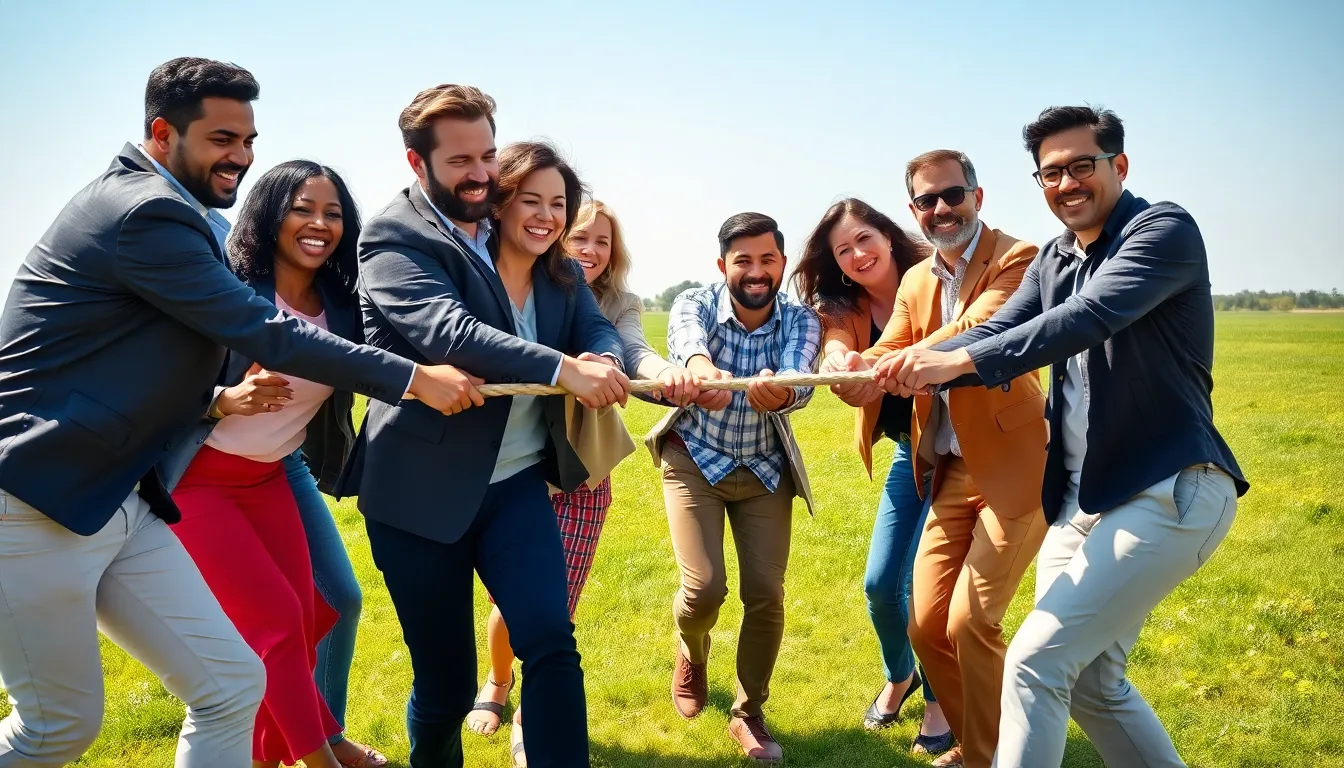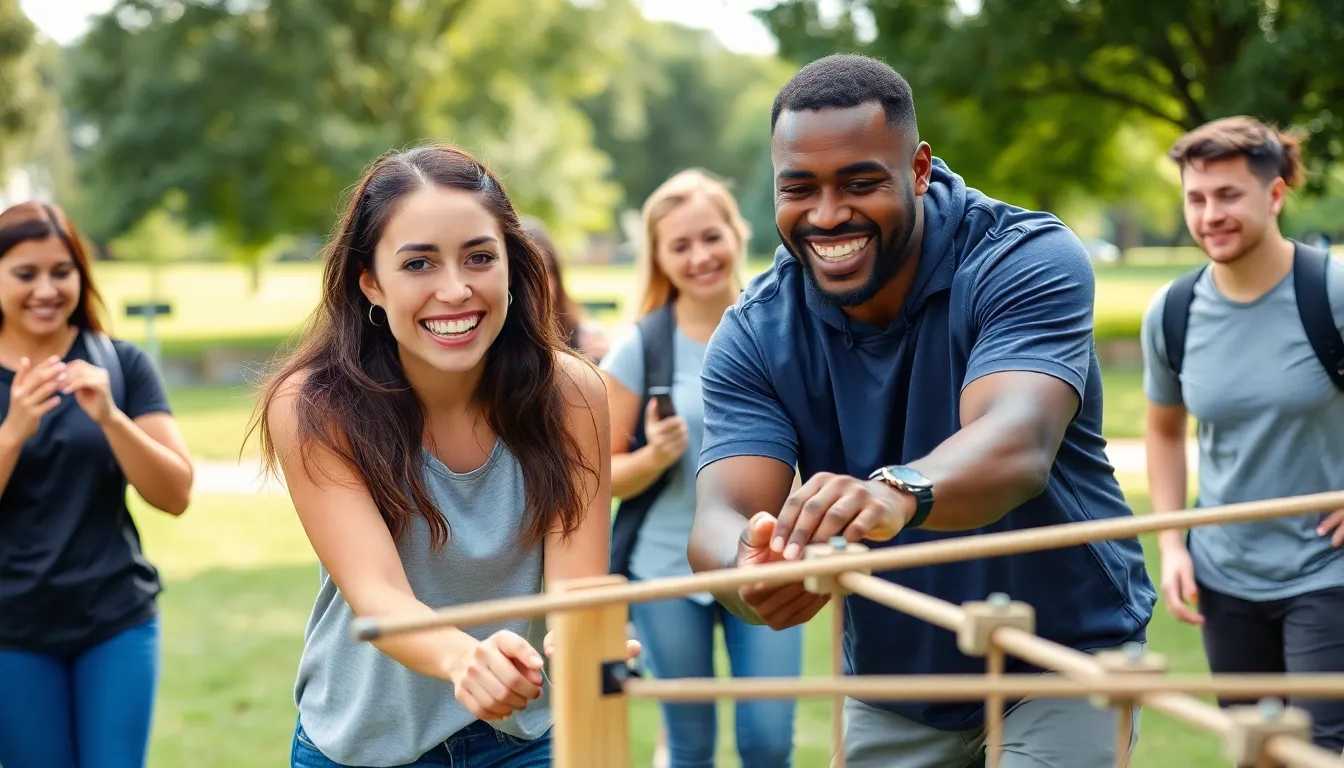In a world where office chairs often double as thrones of solitude, physical team building activities are the secret sauce to transforming coworkers into a cohesive crew. Imagine swapping spreadsheets for tug-of-war ropes and brainstorming sessions for obstacle courses. These activities not only break the ice but also break a sweat, fostering camaraderie and collaboration in the most entertaining way possible.
Table of Contents
ToggleBenefits of Physical Team Building Activities
Physical team-building activities offer numerous advantages that contribute to a productive work environment. Engaging in these activities leads to improved cooperation and stronger relationships among colleagues.
Enhancing Communication Skills
Participating in physical activities fosters open communication. Team members must express their ideas clearly to succeed in tasks, resulting in enhanced verbal skills. Activities create opportunities to practice active listening and encourage collaboration. Many games, such as relay races, require participants to relay information succinctly, reinforcing effective exchange. These interactions not only improve overall communication but also break down barriers that often exist in traditional office settings.
Building Trust Among Team Members
Trust forms the foundation of effective teamwork. Physical activities naturally promote reliance on each other, therefore enhancing trust levels. Collaborative challenges compel team members to depend on each other, fostering confidence in their colleagues’ abilities. Engaging in shared experiences facilitates vulnerability, allowing individuals to build deeper connections. Activities that require problem-solving under pressure can reinforce this trust, as team members learn to navigate challenges together, solidifying strong bonds in the process.
Types of Physical Team Building Activities

Physical team-building activities can take various forms, encompassing both outdoor and indoor options that foster collaboration and engagement among team members.
Outdoor Activities
Outdoor activities often involve active participation and provide a refreshing change from the work environment. Common examples include obstacle courses, relay races, and scavenger hunts. These events encourage teamwork as members strategize and communicate to succeed. Activities like hiking or kayaking promote physical fitness while reinforcing trust and camaraderie. When teams work together to navigate challenges in nature, they build stronger connections and improve morale. These shared experiences often generate lasting memories that enhance workplace dynamics.
Indoor Activities
Indoor activities cater to diverse environments and can be organized regardless of weather conditions. Team-building exercises like trust falls, escape rooms, or team sports keep participants engaged and focused. Interactive games can also trigger creativity and foster problem-solving skills. Activities such as dance-offs or cooking challenges facilitate collaboration in a fun, relaxed setting. Utilizing available space effectively allows teams to bond and develop strong interpersonal skills. Structured indoor tasks often reveal individual strengths while bolstering overall group cohesion.
Planning Effective Physical Team Building Activities
Effective planning maximizes the benefits of physical team-building activities, ensuring participants engage and grow together as a team.
Setting Goals and Objectives
Establishing clear goals drives the success of team-building activities. Teams must focus on objectives like enhancing communication or increasing trust. Specific, measurable goals lead to targeted outcomes, allowing for meaningful reflection on improvement. For instance, if the aim involves developing collaboration skills, selecting activities that require teamwork and strategy is essential. Keeping everyone informed about these objectives aligns efforts and maintains motivation throughout the activities.
Choosing the Right Activity
Selecting appropriate activities is crucial for engagement and effectiveness. Consider the team’s interests, physical abilities, and comfort levels. Assessing these factors leads to choosing activities that everyone can enjoy, like scavenger hunts or team sports. Activities should match the team’s dynamic to maximize participation and collaboration. Indoor activities may suit teams that prefer a controlled environment, while outdoor options can energize participants. Ultimately, aligning the selected activities with team preferences fosters enthusiasm and improves overall results.
Challenges and Considerations
Organizing physical team-building activities involves several challenges that require careful consideration. First, ensuring inclusivity is essential. Activities must accommodate varying fitness levels and physical abilities to engage everyone effectively.
Scheduling poses another challenge. Coordinating a time that fits all team members can be difficult. Advanced planning has proven effective in securing participation, allowing teams to choose dates before scheduling conflicts arise.
Safety represents a critical consideration. Implementing necessary precautions can prevent injuries during physical activities. Organizations should assess activities for risks, providing proper equipment and instruction to create a secure environment for all involved.
Budget constraints also impact planning. Understanding the available financial resources helps teams prioritize activities that deliver the best value. Allocating funds for engaging yet safe experiences can enhance participation without exceeding limits.
Monitoring engagement is crucial throughout. Observations during physical activities reveal the effectiveness of team dynamics. Continuously assessing the group’s response can lead to adjustments that enhance experiences and outcomes.
Feedback after each activity is vital. Gathering insights from participants helps refine future planning. Addressing concerns or suggestions fosters an ongoing conversation about team-building success and creates a more engaged group.
Considering logistics enhances the effectiveness of physical activities. Selecting suitable locations that align with the activity, whether indoors or outdoors, contributes to the overall success of the event. Proper venue selection allows teams to focus on team-building instead of logistical concerns.
Overall, understanding these challenges and considerations strengthens the planning process for physical team-building activities, increasing their potential impact on team cohesion and collaboration.
Physical team-building activities are essential for fostering a strong and cohesive workplace. They not only enhance communication and trust but also create lasting memories that can significantly improve team dynamics. By engaging in both outdoor and indoor activities, teams can explore their strengths and build relationships in a fun environment.
Effective planning is crucial to ensure these activities meet the diverse needs of all team members. With the right approach, organizations can overcome challenges like inclusivity and scheduling while maximizing the benefits of these experiences. Investing in physical team-building activities is a strategic way to cultivate collaboration and a positive work culture, ultimately leading to a more engaged and productive team.







